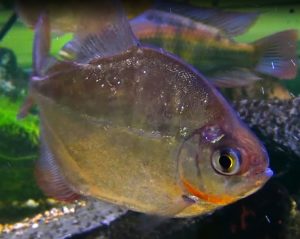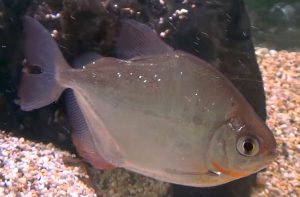Silver Dollar (Metynnis argenteus) is a generic name that is attributed to a number of tropical species in the Characidae (Serrasalmidae) family that are closely related to the South American Pacu and Piranha. All are popular with tropical fish keeping enthusiasts.
This Silver Dollar (Metynnis argenteus), is endemic to the Rio Tapajós drainage, in Brazil and except for the black shoulder patch that they possess slightly above and behind each eye, they are identical to the “common” Silver Dollar (Metynnis hypsauchen) in appearance.
All Silver Dollar species are found in tropical climates and prefer highly vegetated, weedy river tributaries, with low light conditions.
Like most Silver Dollars, Metynnis argenteus is a peaceful, skittish, schooling species that inhabits the densely vegetated river tributaries of their range. Although they are primarily vegetarians and voracious plant eaters, they are opportunistic feeders and will also eat earthworms, small insects, small crustaceans, and small fish. In an aquarium environment, they will wreak havoc in a well planted tank unless additional vegetable matter is provided.
Although Metynnis argenteus is listed as a semi aggressive species, they are more like Pacu in temperament.
Juvenile Metynnis argenteus can be housed in a peaceful community tank with fish of the same size but if a tankmate can fit into their mouth, they will eat it. Adults should be housed with larger catfish, other silver dollar species, Oscars, Pacu, etc.
As their name implies, the Silver Dollar (Metynnis argenteus) has a silvery, round, laterally compressed body with a black shoulder patch slightly above and behind their eye. They have small scales give them a sheen of green and blue when viewed at certain angles. The anal fin of the male is edged in red which becomes more pronounced during breeding, and a few species have small dots on their flanks.
Silver Dollars are best housed in a densely planted aquarium of at least 55 gallon capacity with a dark gravel substrate, some pieces of driftwood for them to hide among, a few rocks, and some floating plants to diffuse overhead lighting. Hardy plants like Java Fern
, Hornwort, etc. should be provided to minimize grazing. A shallow, peat filtered tank is also recommended to replicate their water parameters.
Being a schooling species, Metynnis argenteus do best when kept together with at least 5 or 6 other individuals in a single species biotope setup. In a peaceful community tank setting with other larger fish, at least 3 or 4 should be kept together with plenty of hiding places, to keep them from becoming overly skittish and reclusive.
The best way to breed Metynnis argenteus is to purchase 6 or more juveniles and raise them together in a large tank to adulthood until a pair, or pairs can be identified.
Their breeding tank should be heavily planted with fine leaved plants and have subdued lighting. The water should be kept at a temperature of 80 to 82 degrees F, the pH slightly acidic, and at a hardness at 8 dgH or less.
The colors around the anal, caudal, and dorsal fins of the male will become darker, and the red around the chest area will intensify, when the male is ready to spawn. He will begin chasing the females around the tank and shimmy up close to them to get them ready to spawn.
When a female is ready to breed, she will release up to 2,000 eggs which, after being fertilized by the male, will drop to the bottom of the tank. The eggs will hatch out in about 3 days at a temperature of 82 degrees F.
Silver Dollars (Metynnis argenteus) are not likely eat their eggs or fry, but it is always better to remove them to another tank after spawning. A week or so after hatching, the fry will absorb their yolk sacs, become free swimming, and be fed infusoria until they are able to consume freshly hatched brine shrimp, finely crushed spirulina, or commercial prepared fry foods.
Because egg mortality can be quite high, many breeders keep a layer of Indian Almond Leaves on the bottom of the breeding tank to promote the growth of humic substances which act as an antibacterial and antifungal agent to minimize losses.
All Silver Dollars require a huge amount of vegetable matter in their diet. They can be fed commercial algae wafers, Spirulina flakes, and regular offerings of cucumbers, lettuce, peas, zuchinni, etc. They will also eagerly accept occasional offerings of fresh, frozen, or freeze dried bloodworms, earthworms, ghost shrimp
, and brine shrimp.
Metynnis argenteus are readily available in tropical fish keeping shops and online at reasonable prices. They are usually sold as juveniles when they are 1 1/2″ – 2 3/4″ or larger in size.
Minimum Tank Size: 75 gallons
Care Level: Moderate
Temperament: Peaceful
Aquarium Hardiness: Moderately Hardy
Water Conditions: 75-82 °F°, <10dgH, pH 6.0-7.0
Max. Size: 6″
Color Form: Silver
Diet: Omnivorous (primarily Herbivorous)
Compatibility: Aggressive to small fish
Origin: Brazil
Family: Characidae (Serrasalmidae)
Life Span: 15 years or more
Aquarist Experience Level: Intermediate




The fish shown are Metynnis altidorsalis, 2 males and 1 female